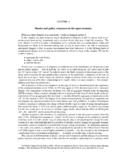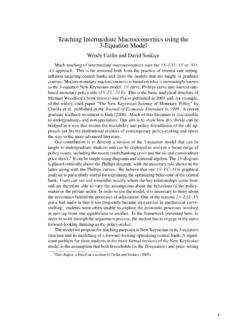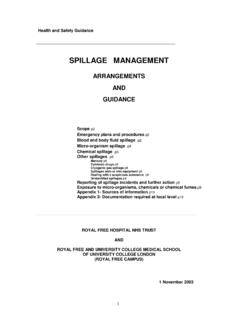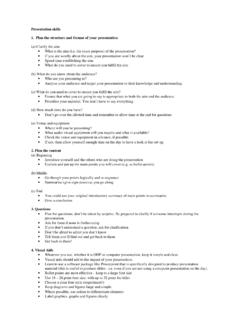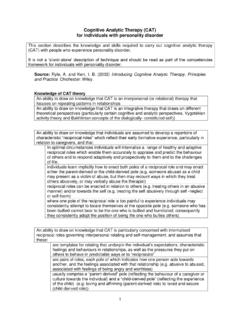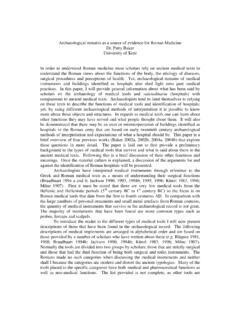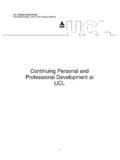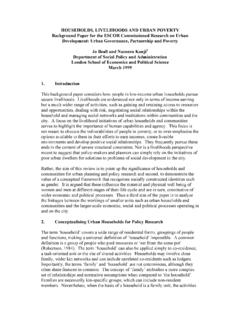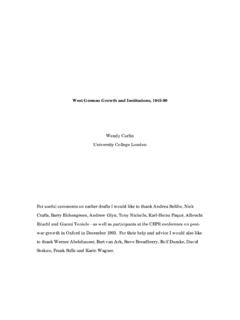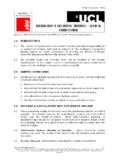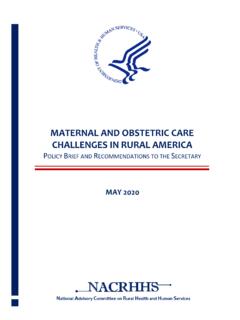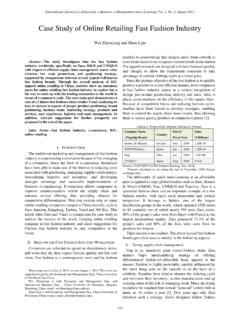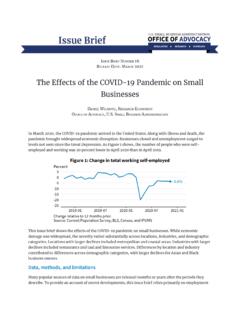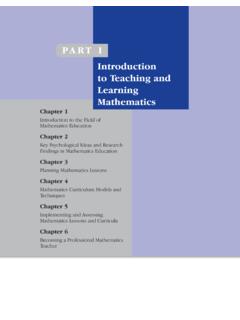Transcription of This report is based on independent research commissioned
1 This report is based on independent research commissioned from the Children's Policy research Unit and funded by the National Institute for Health research Policy research Programme. The views expressed are those of the author(s) and not necessarily those of the NHS, the National Institute for Health research , the Department of Health and Social Care or its arm's length bodies, and other Government Departments. Shabeer Syed Researcher in Psychiatric Epidemiology, UCL Great Ormond Street Institute of Child Health. Children's Policy research Unit - Coordinating Investigator. Ruth Gilbert Professor of Clinical Epidemiology, UCL Great Ormond Street Institute of Child Health. Theme lead for Healthcare Provision, Children's Policy research Unit - Co-principal investigator.
2 Miranda Wolpert Professor of Evidence- based Practice and research at UCL, and director of the Child Outcomes research Consortium (CORC) and of the Evidence- based Practice Unit. Theme lead for Mental Health, Children's Policy research Unit - Co-Principal Investigator. This report would not have been possible without the invaluable feedback of our steering group: Mr Andrew Brown Senior Programme Manager at Public Health England, substance misuse and public health policy expert. Dr Emily Finch Consultant Addiction Psychiatrist and Clinical Director at the addictions Clinical Academic Group, South London and Maudsley NHS. Foundation Trust. Prof Gene Feder Professor of Primary Care and domestic violence research expert, University of Bristol. Dr Janice Allister General Practitioner and safeguarding expert at the Royal College of General Practitioners.
3 Prof Richard Velleman Emeritus Professor of Mental Health research at the University of Bath, and Senior research Fellow at Sangath Community Health NGO, expert on interventions for substance misuse among families. Prof Yvonne Kelly Professor of Life course Epidemiology and expert on child and adolescent developmental health, University College London. We also acknowledge the important contributions of: Addaction: Anna Penn, Head of Breaking the Cycle Family Services Avon Longitudinal Study of Parents and Children: Dr Liam Mahedy, Senior research Associate in Epidemiology and Medical Statistics, University of Bristol Clinical Record Interactive Search: Dr Martha Canfield, research Associate, Kings College London Children's Policy research Unit (University College London): Dr Chloe Parkin, Heng Fang, Kate Lewis, Dr Linda Wijlaars, Matthew A.
4 Jay, Dr Sanjay Parekh, Dr Steven Hope and Toqir Mukhtar Family Nurse Partnership NHS: Ailsa Swarbrick, Andreea Moise and Philip Howlin The National Association for Children of Alcoholics: Amanda Brett Identification and Referral to Improve Safety (IRISi): Medina Johnson (CEO). Royal College of General Practitioners research and Surveillance Centre (University of Surrey): Dr Hilary Davies-Kershaw, Prof Simon de Lusignan, Dr Filipa Ferreira, Dr John Williams and Dr Harshana Liyanage Public Health England: Pauline Fisher (Programme Manager). 1. EXECUTIVE SUMMARY 3. INTRODUCTION 3. METHODS 3. KEY FINDINGS 3. RECORDED PREVALENCE OF PAM ACROSS SERVICES 3. INTERVENTIONS FOR PAM AND AFFECTED CHILDREN 4. RECOMMENDATIONS 4. CHAPTER 1: BACKGROUND 5. INDIVIDUAL AND SOCIETAL CONTEXTS 5.
5 INTERVENTIONS 5. DEFINITION OF ALCOHOL MISUSE 5. EPIDEMIOLOGY 5. WHY THIS REVIEW NOW? 6. AIMS 6. CHAPTER 2: SERVICE PRESENTATIONS 7. DATA SOURCES 7. INCLUSION CRITERIA 7. CLASSIFICATIONS OF INDICATORS 7. STATISTICAL ANALYSIS 8. ETHICS 8. WHERE DO FAMILIES PRESENT TO SERVICES? 8. PRIMARY CARE 8. GENERAL PRACTICES 8. OTHER COMMUNITY SERVICES 8. HELPLINES 12. SECONDARY CARE 12. HOSPITAL ADMISSIONS FOR MOTHERS 12. HOSPITAL ADMISSIONS FOR CHILDREN 12. ADULT MENTAL HEALTH SERVICES 12. PERINATAL MENTAL HEALTH SERVICES 12. CHILD AND ADOLESCENT MENTAL HEALTH SERVICES 12. SOCIAL CARE 13. CHILDREN AND FAMILY COURT 13. SERIOUS CASE REVIEWS 13. CHILDREN IN NEED, CHILDREN LOOKED AFTER AND THE NATIONAL PUPIL DATASET 13. COHORT STUDIES 13. PARENTAL ALCOHOL MISUSE OVER THE CHILD'S LIFE COURSE 13.
6 CAVEAT 14. CHAPTER 3: INTERVENTIONS 15. METHODS 15. DATA SOURCES 15. INCLUSION CRITERIA 15. OVERVIEW OF INCLUDED STUDIES 16. POPULATION 17. 2. INTERVENTIONS 17. PREVENTION STRATEGIES: HEALTH PROMOTION, ASSESSMENTS AND BRIEF INTERVENTIONS 21. MULTIMEDIA HEALTH PROMOTION PROGRAMMES 21. BRIEF INTERVENTIONS (BI) 21. PRIMARY CARE ASSESSMENTS 21. SCHOOL- based INTERVENTIONS 22. PSYCHOEDUCATIONAL GROUP (PG) 22. ONLINE INTERVENTIONS AND HELPLINES 23. PSYCHOLOGICAL THERAPIES 23. INDIVIDUAL PSYCHOLOGICAL THERAPIES 23. BEHAVIOURAL COUPLES THERAPY (BCT) 23. FAMILY- based INTERVENTIONS 23. COMMUNITY REINFORCEMENT AND FAMILY TRAINING (CRAFT) AND MINORITIES 23. STRENGTHENING FAMILIES PROGRAMMES (SFP) 24. HOME VISITATION PROGRAMMES (HVP) 25. PARENTING PROGRAMMES (PPS) 25.
7 FAMILY THERAPY 25. INTEGRATED TREATMENTS (IT) 26. INTENSIVE CASE MANAGEMENT (ICM) 26. INTENSIVE FAMILY PRESERVATION PROGRAMMES 27. ICM IN CHILDREN'S SOCIAL CARE FOR OUT OF HOME PLACEMENTS 27. COMMUNITY OUTREACH 28. CRIMINAL AND JUSTICE SYSTEM 28. FAMILY DRUG AND ALCOHOL COURT (FDAC) 28. POLICE 29. PHARMACOLOGICAL INTERVENTIONS 29. UPCOMING INTERVENTIONS 29. CAVEAT 29. CONCLUSIONS 30. REFERENCES 32. APPENDICES 56. APPENDIX 1. ABBREVIATIONS 57. APPENDIX 2. REVIEW PROTOCOL & SEARCH STRATEGY (PROSPERO FORMAT UNREGISTERED) 58. APPENDIX 3. CHARACTERISTICS OF INCLUDED DATA SOURCES AND INDICATORS FOR ESTIMATING PREVALENCE OF PAM ACROSS SERVICES 62. APPENDIX 4. CHARACTERISTICS OF INCLUDED DATA SOURCES AND INDICATORS FOR ESTIMATING PREVALENCE OF PAM ACROSS THE CHILD'S LIFE COURSE 66.
8 APPENDIX 5. CHARACTERISTICS OF INCLUDED INTERVENTION STUDIES 67. APPENDIX 6. CHARACTERISTICS OF UPCOMING UK RCTS FOR PAM IDENTIFIED IN TRIAL DATABASES 80. APPENDIX 7. ALCOHOL CLASSIFICATIONS AND CUT-OFF SCORES USED TO CALCULATE ALCOHOL MISUSE SEVERITY CATEGORIES FOR DIFFERENT MEASURES 81. APPENDIX 8. PUBLIC HEALTH ENGLAND'S NARROW MEASURE OF ICD-10 CODES FOR ANALYSIS IN HES-APC 82. APPENDIX 9. DRUG AND ALCOHOL-RELATED ICD-10 CODES FOR ANALYSIS IN HES-APC (EXCLUDING PHE NARROW MEASURE; APPENDIX 7) 83. APPENDIX 10. ALCOHOL-RELATED READ CODES FOR ANALYSIS IN CPRD 85. 3. Summaries below contain key messages, and where Parental alcohol misuse (PAM) can have profound relevant, we draw on earlier published reviews and effects on children's health and development.
9 Yet, the recommendations by NICE, the RGCP and ,9-14 An extent to which the government, local authorities or overview of recommendations is provided at the end. clinical services are addressing PAM is not well understood. This rapid review was commissioned from the Children's Policy research Unit (CPRU) by the Department of Health and Social Care (DHSC) to inform Cohort studies show that between 14% and national and local policy interventions for children 26% of fathers with children aged 9-12 months affected by PAM. It combines published research and 14 years drink at levels classified as (emphasising findings from systematic reviews), increased risk drinking, and between 5% and administrative data, birth cohort studies and expert 18% of mothers drink at levels classified as feedback to seek answers on: increased risk drinking (See Box 1 on for alcohol misuse definitions).
10 1. How do families who are affected by PAM. present to services? Cohort studies show that the prevalence of Objective: Review prevalence of PAM in England, as PAM increases with a child's age, and was recorded by services where children and parents lowest for mothers during pregnancy and present. highest for parents between child ages 12 and 14 years old. 2. What strategies to reduce PAM and its consequences for children could be integrated into existing services? In comparison to birth cohort studies, PAM was Objective: Review interventions aimed at reducing substantially under-recorded by all services PAM and related-harms among children. across health and children's social care. Though, the recording was higher for services This report should be considered in conjunction with connected to the National Drug and Alcohol the substantial evidence base on risk factors and Treatment Monitoring System.
